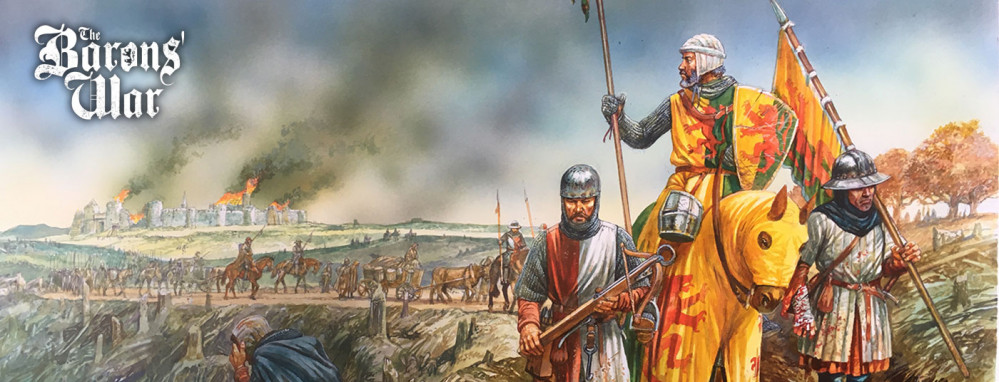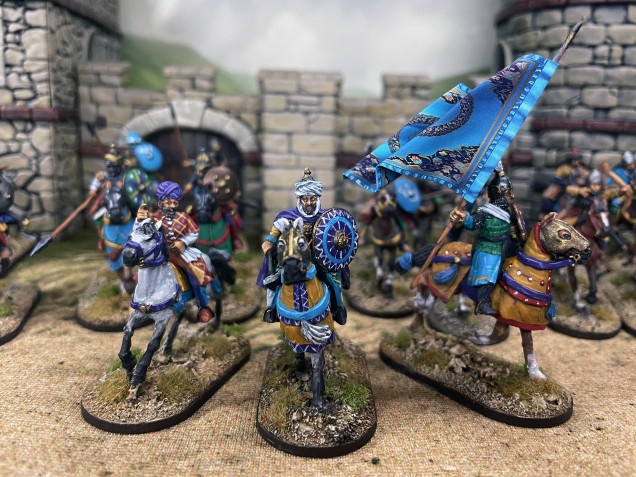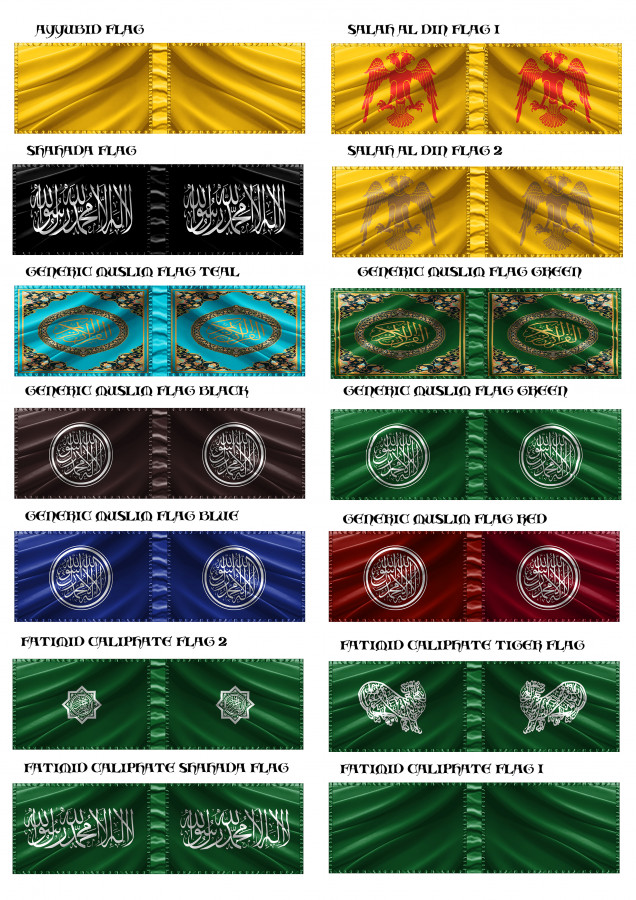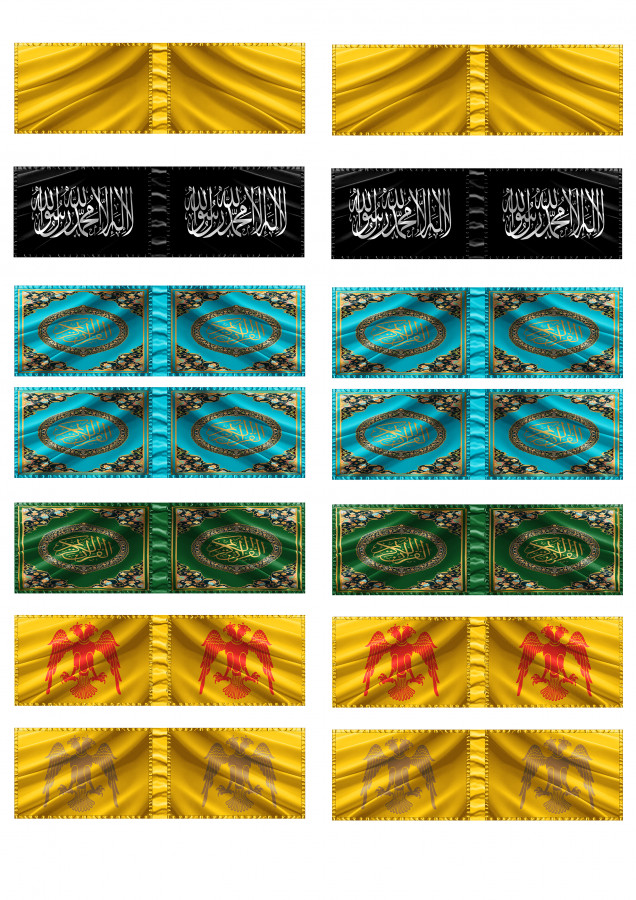
PanzerKaput Goes To Barons' War
Ayyubid and Muslim flags
I have created some flags for my Muslim flags for Barons War, especially the Ayyubid faction, the forces of Salah al Din, Saladin. I thought there was little information on medieval shield design and a like but there is even less on the Islamic forces in the 12th and 13th century.
I have decided to go with what information I can find as it looks like the Muslim forces preferred plain single colour flags as opposed to multi coloured designs, this much later.
I have meaning worked on the Ayyubids and Fatimids flags as well as some generic, conjecture based flags.
The Tawheed flag, which is commonly used as a flag representing Islam.
An Islamic flag is the flag either representing an Islamic Caliphate or religious order, state, civil society, military force or other entity associated with Islam. Islamic flags have a distinct history due to the Islamic prescription on aniconism, making particular colours, inscriptions or symbols such as crescent-and-star popular choices. Since the time of the Islamic prophet Muhammad, flags with certain colours were associated with Islam according to the traditions. Since then, historical Caliphates, modern nation states, certain denominations as well as religious movements have adopted flags to symbolize their Islamic identity.
Early Islam
Before the advent of Islam, banners as tools for signaling had already been employed by the pre-Islamic Arab tribes and the Byzantines. Early Muslim army naturally deployed banners for the same purpose. Early Islamic flags, however, greatly simplified its design by using plain colour, due to the Islamic prescriptions on aniconism. According to the Islamic traditions, the Quraysh had a black banner and a white-and-black banner. It further states that Muhammad had a banner in white nicknamed “the Young Eagle” (Arabic: العقاب, al-ʿuqāb); and a flag in black, said to be made from his wife Aisha’s head-cloth. This larger flag was known as the “Banner of the Eagle” (Arabic: الراية العقاب, romanized: al-rāyat al-ʿuqāb), as well as the “Black Banner” (Arabic: الراية السوداء, romanized: al-rāyat as-sawdāʾ). In the Islamic tradition, Muhammad used the white flag to represent both the leader of the Muslim army and the Muslim state. Other examples are the prominent Arab military commander ‘Amr ibn al-‘As using a red banner, and the Khawarij rebels using a red banner as well. Banners of the early Muslim armies in general, however, employed a variety of colours, both singly and in combination.
The Umayyad Caliphate, which ruled the largest geographical extent of the medieval Islamic Empire adopted white flags. During the Abbasid Revolution, the Abbasids incorporated the Black Standard based on the early Islamic eschatological saying that “a people coming from the East with black banners” would herald the arrival of the messianic figure Mahdi. The Shiite Alids chose the colour of white to distinguish themselves from the Abbasids, but also adopted green flags. Thus in 817, when the Abbasid caliph al-Ma’mun adopted the Alid Ali al-Ridha a his heir apparent, he also changed the dynastic colour from black to green. The change was reverted when al-Ma’mun had Ali killed, and returned to Baghdad in 819. The Abbasids continued to use black as their dynastic colour. However, their caliphal banner was made of white silk with the Quranic inscriptions. The white colour was then adopted, in deliberate opposition to the Abbasids, by the Ismaili Shiite Fatimid Caliphate, and cemented the association of black and white with Sunni and Shia respectively. It was also used by the Almohads. The Fatimid caliphal banner was decorated in red and yellow, sometimes emblazoned with the picture of a lion. Early Muslim rulers are generally not known to have used emblems of a distinctly dynastic, religious, or personal nature.
Black standards are attributed to Muhammad and were used by the Abbasid Caliphate
The Umayyad Caliphate, Fatimid Caliphate and Almohad Caliphate used white standards. White flags are also attributed to Muhammad.
Green flags were sometimes used by Shi’ites.
The Kharjites used red standards
Middle Ages
The Ayyubids and Mamluks, succeeding the Fatimid caliphate, retained the association with yellow. The Ayyubid founder Saladin carried a yellow flag adorned with an eagle. Mamluk sultanic banners were yellow, but on occasion they used red banners. Mongol and Turkic dynasties to the east, including the Ilkhanate, Oghuz Turks and the Seljuq dynasty, preferred the white banner. Religious flags with inscriptions were in use in the medieval period, as shown in miniatures by 13th-century illustrator Yahya ibn Mahmud al-Wasiti. 14th-century illustrations of the History of the Tatars by Hayton of Corycus (1243) shows both Mongols and Seljuqs using a variety of war ensigns.
The crescent appears in flags attributed to Tunis from as early as the 14th century Book of Knowledge of All Kingdoms, long before Tunis fell under Ottoman rule in 1574. The Spanish Navy Museum in Madrid shows two Ottoman naval flags dated 1613; both are swallow-tailed, one green with a white crescent near the hoist, the other white with two red stripes near the edges of the flag and a red crescent near the hoist.
The hexagram was also a popular symbol among the Islamic flags. It is known in Arabic as Khātem Sulaymān (Seal of Solomon; خاتم سليمان) or Najmat Dāūd (Star of David; نجمة داوود). The “Seal of Solomon” may also be represented by a five-pointed star or pentagram. In the Qur’an, it is written that David and King Solomon (Arabic, Suliman or Sulayman) were prophets and kings, and are figures revered by Muslims. The Medieval pre-Ottoman Hanafi Anatolian beyliks of the Karamanids and Jandarids used the star on their flag.
The Mamluks served the Custodian of the Two Holy Mosques during their reign. During this time, they deployed what was believed to be the genuine relic of the Islamic prophet Muhammad’s banner. The banner was later captured by the Ottomans, who called the flag the “noble banner” (Sancak-ı Şerif) and used it during their military campaign. The flag was made of black wool, according to the Ottoman historian Silahdar Findiklili Mehmed Agha, but there is no further information available.
| Symbol | Image | History and usage |
|---|---|---|
| Crescent (Hilāl) | The crescent appears to have been adopted as an emblem on Islamic military flags from the medieval period, possibly in response to the Crusaders’ cross. The Red Crescent has been used as a replacement of the Red Cross as early as in the Russo-Turkish War of 1877 and was officially adopted in 1929. | |
| Star and crescent | The star and crescent moon was created in Islam by the Umayyads, even though it is commonly associated with the Ottoman Empire, and later came to commonly symbolize Islam, especially in the Western world before attaining more universally Muslim connotations. | |
| Allah | Means “God” in Arabic and used by Muslims worldwide irrespective of the language spoken. The word written in Islamic calligraphy is widely used as a symbol of Islam in the Muslim world. | |
| Shahadah | Parts of it are mentioned in the Quran separately, but never in its complete form. Used in hadiths and many historical Muslim and Islamist flags and emblems. | |
| Rub el Hizb | The Rub el Hizb (Islamic Star) is used to facilitate recitation of the Quran. The symbol is also found on a number of emblems and flags especially the state of Fez during the Marinid Sultanate. | |
| Khatim | Khatim symbol (Black Star) is known as the seal of Muhammad. | |
| Sujud Tilawa | Used in the Quran to indicate when the reader should perform sujud, the act of low bowing or prostration in worship of God. |
History
Early Islamic armies and caravans flew simple solid-coloured flags (generally black or white) for identification purposes, with the exception of the Young Eagle of Muḥammad, which had the shahada inscribed upon it. In later generations, the Muslim leaders continued to use a simple black, white, or green flag with no markings, writings, or symbolism on it.
The Umayyads fought under white and green banners. The Abbasids chose black (blue) and fought with black banners. The Fatimids used a green standard, as well as white. The Saudi Emirate of Diriyah used a white and green flag with the shahada emblazoned on it. Various countries in the Persian Gulf have red flags. The four Pan-Arab colours, white, black, green and red, dominate the flags of Arab states.
- Green – The silk and pillows of Jannah are believed to be green.
- White – Considered the purest and cleanest colour in Islam and the colour of the flag of Muḥammad, the Young Eagle.
- Black – The colour of Jahannam as well as the color of the Black Standard.
The Black Standard
The Black Standard is one of the flags flown by Muhammad in Muslim tradition. It was historically used by Abu Muslim in his uprising leading to the Abbasid Revolution in 747 and is also associated with the Abbasid Caliphate. It is also a symbol and is associated with Islamic eschatology (heralding the advent of the Mahdi).
The Star and Cresent
The crescent is usually associated with Islam and regarded as its symbol. The crescent and star had been used by royalty in the Sassanid Persian Empire, so it was adopted for similar uses by Umayyad Caliphate Muslims after the Rashidun Caliphate’s conquest of the region. However, the symbol only came into widespread use after it was associated with the Ottoman Empire, who took it from being the symbol of Constantinople after their takeover of the city. By extension from the use in Ottoman lands, it became a symbol also for Islam as a whole, as well as representative of western Orientalism. “Crescent and Star” was used as a metaphor for the rule of the Islamic empires (Ottoman and Persian) in the late 19th century in British literature. This association was apparently strengthened by the increasingly ubiquitous fashion of using the crescent and star symbol in the ornamentation of Ottoman mosques and minarets. By contrast, the majority of religious Islamic publications emphasize that the crescent is rejected “by some Muslim scholars”. The “Red Crescent” emblem was adopted by volunteers of the International Committee of the Red Cross (ICRC) as early as 1877 during the Russo-Turkish War; it was officially adopted in 1929.
Rub el Hizb
The Rub el Hizb is used to facilitate recitation of the Quran. The symbol determines every quarter of Hizb, while the Hizb is one half of a juz’. The symbol is also found on a number of emblems and flags, such as that of the Marinid Sultanate.
Khatim
Seal of the Prophets (Khatim) a title used in the Qur’an and by Muslims to designate Muhammad as the last of the prophets sent by God.
Shahadah
Shahadah is one of the Five Pillars of Islam and part of the Adhan. It reads: “I bear witness that none deserves worship except God, and I bear witness that Muhammad is the messenger of God.”
Religious flags with inscriptions were in use in the medieval period, as shown in miniatures by 13th-century illustrator Yahya ibn Mahmud al-Wasiti. 14th-century illustrations of the History of the Tatars by Hayton of Corycus (1243) shows both Mongols and Seljuqs using a variety of war ensigns.


































![TerrainFest 2024! Build Terrain With OnTableTop & Win A £300 Prize [Extended!]](https://images.beastsofwar.com/2024/10/TerrainFEST-2024-Social-Media-Post-Square-225-127.jpg)




















































SWEET!!! LOVE EM!
Thanks there and I am rather pleased with them